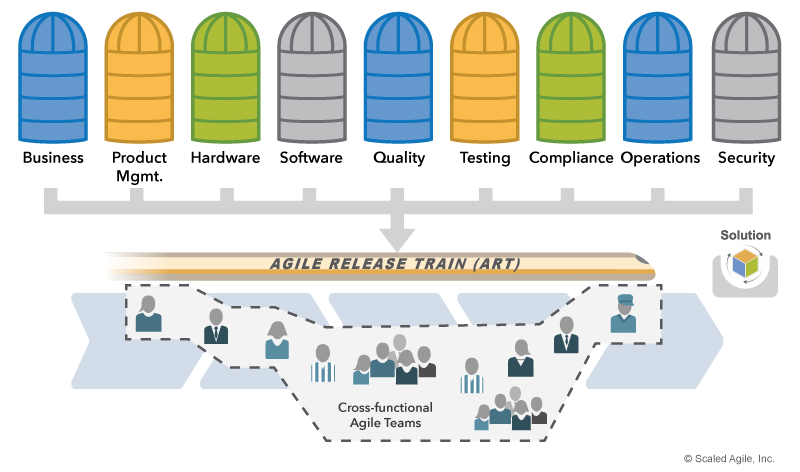Master Retrospectives with SAFe: Tips and Formats


As a Scrum Master or Team Coach within the SAFe framework, I quickly realized that the retrospective is a key tool for strengthening team collaboration and performance. It provides a valuable opportunity to reflect on what worked well, identify areas for improvement, and implement concrete actions.
However, in a large-scale environment where multiple teams are working towards common goals, organizing an effective retrospective requires a more rigorous approach. In this regard, SAFe offers different types of retrospectives, each with a specific purpose.
In this article, I will share best practices and some tips from my experience to improve the facilitation of retrospectives in a SAFe context.
Let’s explore the following topics together:
What is the role of the retrospective in SAFe?
In Scrum, the "Sprint" is at the heart of the process. It is short (often two to four weeks) and always ends with a retrospective, allowing the team to reflect on what went well, what can be improved, and the next actions to take. The goal is to improve continuously with each sprint. The format may vary, but the objective remains the same.
SAFe, on the other hand, is structured into levels (Team, Program, Portfolio), forming Agile Release Trains (ARTs) that deliver value. To unify everything, SAFe introduces the Program Increment (PI) concept, which is a longer cycle, typically lasting 8 to 12 weeks, and includes several iterations (the equivalent of a Sprint in Scrum). Therefore, for alignment reasons, several formats of retrospective occur within the same PI.
The complexity of SAFe lies in coordinating numerous teams and artifacts to ensure that the entire organization remains aligned with strategic objectives.

In this scaled context, SAFe offers three main types of retrospectives, each addressing specific needs depending on the point in the PI cycle: the Iteration Retrospective, the Inspect & Adapt Retrospective, and the PI Planning Retrospective. In the next section, we will review these three events prescribed by Scaled Agile to understand their core purpose.
"Multi-learning serves as a basis for creating a climate that can bring about organizational transition."
The Iteration Retrospective
Let’s start with the Iteration Retrospective: just like in Scrum, it allows the team (excluding external members) to reflect on what happened during the completed iteration. Scaled Agile recommends 1 to 1.5 hours for a retrospective for a two-week iteration.
During this meeting, Scaled Agile suggests the following agenda:
Part 1: Quantitative Measurement
Review the improvement backlog items targeted for this iteration. Were they all completed?
Did the team meet its iteration goal (yes/no)?
Collect and examine the agreed-upon iteration metrics.
Part 2: Qualitative Measurement
What went well?
What didn’t go well?
What can we improve next time?
What should we maintain?
This is therefore a meeting held by the team, for the team. Now, let’s move on to the second meeting, which requires taking a more high-level perspective.
Inspect & Adapt Workshop Retrospective
To conclude the current PI, there is the Inspect & Adapt (I&A) Retrospective. During the half-day dedicated to the I&A, a portion focuses on the retrospective of the ending PI. This retrospective highlights the challenges and successes observed at the train level. Here, the emphasis is more on the connections and interdependencies between teams, thus operating at a higher level than an Iteration Retrospective.
It also serves as a starting point for the final part of the I&A event: problem-solving. It’s important to allocate enough time to list the problems encountered during the PI, so that the most significant one can be selected and addressed afterward.
Lastly, we will now look at the final segment related to the analysis of the event that wraps up the PI—before the next one begins.
PI Planning Retrospective
The PI concludes with the PI Planning Retrospective. This retrospective allows teams to reflect on how the two-day event went after planning for the next 8 to 12 weeks and setting the objectives the team has committed to. Since this involves building a plan for several iterations of work, it’s important to take a step back before moving forward with renewed energy.
As you can see, the objective behind each retrospective remains the same: to take a moment to reflect on how things went, learn from the experience, and improve for the future.
My Tips for Facilitating a Retrospective in a SAFe Context
There’s no secret: for a meeting to be successful, you need to start by defining its objective and expectations.
As mentioned earlier, the Iteration Retrospective allows the team to reflect on their work, values, and delivery challenges. You’ll likely want to give each team member the opportunity to speak, even diving into very specific topics if necessary. While maintaining the core purpose of the Iteration Retrospective, don’t hesitate to adjust the agenda according to your team’s context. Whether it’s the format or the duration, it’s important to prepare the retrospective to get the most out of it. Personally, I find it risky to dedicate only one hour to such an important meeting.
On the other hand, a retrospective during the Inspect & Adapt event typically requires high-level discussions across the delivery train. Allowing each person to speak could be a challenging task, so it’s crucial to ensure quality contributions for the majority of participants attending the meeting. To stay focused on the meeting’s objective, the Scrum Master/Team Coach, supported by the Release Train Engineer (RTE), should remind the team in advance to prepare their discussion points. Placing discussion items on the board (physical or virtual) beforehand can be a useful approach.
While there is no specific guideline that I’m aware of, 30 to 45 minutes seems appropriate for this part of the I&A, as long as participants agree on the problem to solve afterward.
Regarding the PI Planning Retrospective, I recommend postponing it until the day after the meeting, ideally the first day of the new PI. After a day and a half of effort and planning, it’s natural for team members to lack the energy and mental space to dive into a retrospective. Giving them the rest of the day and night to recharge seems like an easy win to start fresh.
Again, there’s no precise guideline on the duration or format, but my suggestion is to allocate 60 minutes to discuss the event and take note of what should be kept or changed for the next one.
To make these meetings as dynamic as possible, I’ve selected a few formats that I hope will help you.
6 Innovative Retrospective Formats Adapted to SAFe
As mentioned earlier, the approach varies depending on the occasion that calls for a retrospective. As a Scrum Master/Team Coach, you will be responsible for facilitating these events. Here are a few templates that have been useful to me, which I believe can make your life easier in a SAFe context.
1. For the Iteration Retrospective
To help the team focus on the future from the start of the PI, potentially during the first iteration:
The Genie in a Bottle or the Futurespective inspired by Star Wars. These two models encourage thinking about the future, rather than just reflecting on the past.
2. For the PI Planning Retrospective
To reflect on the PI Planning workshop, its organization, and its execution, which can be a draining exercise, I suggest a simple and effective approach:
Plus/Delta or Energy Levels as they allow you to easily gauge the team's sentiment. As a reminder, I also recommend holding this meeting the day after PI Planning.
3. For the Inspect & Adapt Retrospective
To support an entire train during the Inspect & Adapt retrospective, identifying key connections between teams, as well as highlighting interdependencies or blockers that may have hindered value delivery:
The Rock Band or Working vs. Stuck. Here, the focus is on collective reflection to extract issues worth exploring, while also celebrating successes.
These retrospective templates will help you step outside the usual patterns and foster new discussions, all while keeping engagement high.
Conclusion
By mastering the objective of each meeting proposed by SAFe, you’ll be able to facilitate them effectively and extract the most value from each one. Make the most of Coach syncs to raise your challenges, explore possible solutions, and share templates and discussion points.
Additionally, while respecting the essence of SAFe, I suggest taking some liberties to better suit your teams. For instance, extending the duration of the Iteration Retrospective or adjusting the timing of the PI Retrospective.
For several years now, Neatro has made my life much easier and saved me significant preparation time thanks to the available retrospective templates, which I can simply select based on the team’s context or the type of retrospective I’m facilitating.
If you want to learn more, feel free to check out Neatro's retrospective experience. You can launch a Neatro demo presentation here.
And if you’d rather jump straight into action, start using Neatro for free here.



